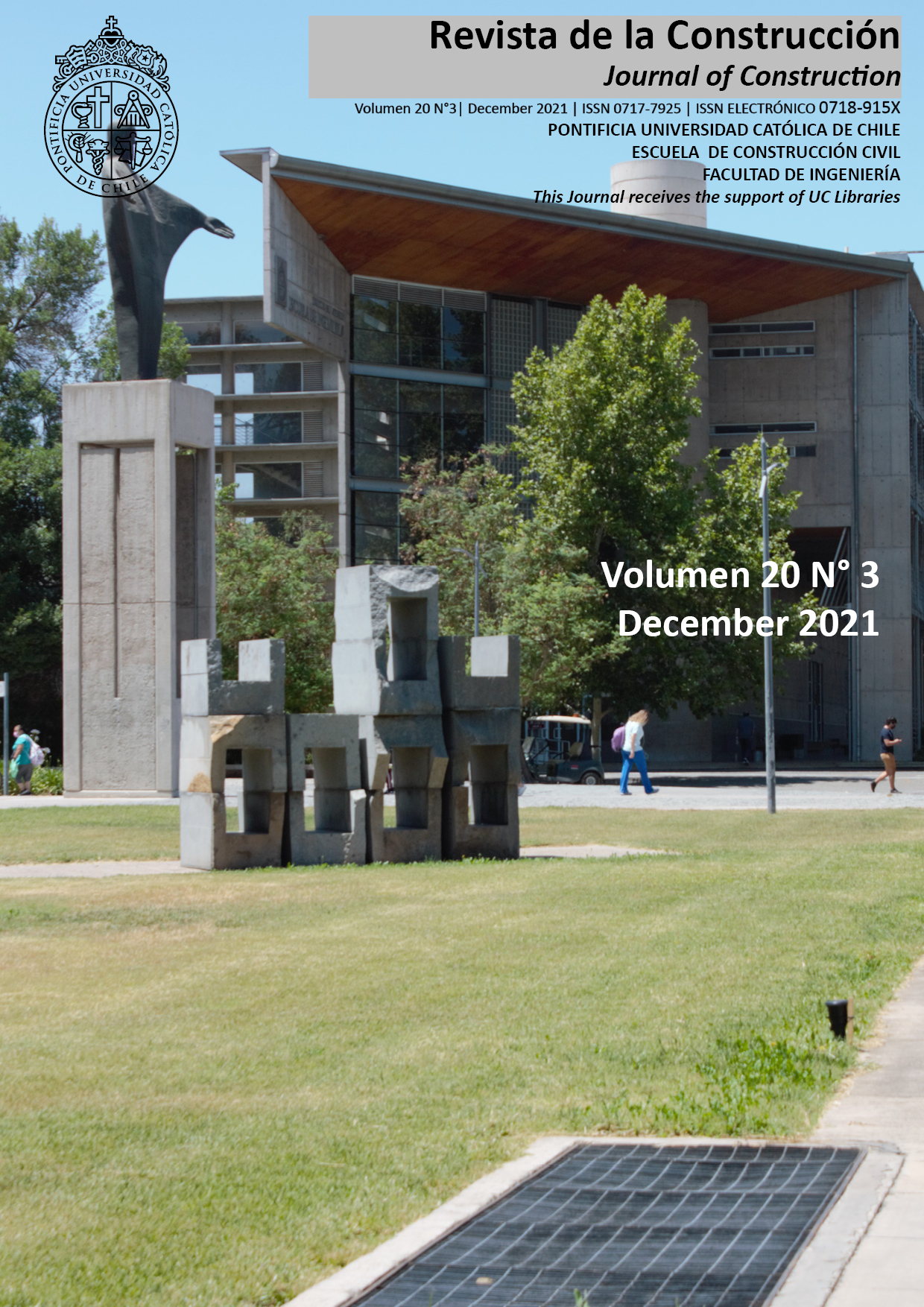Static and dynamic camber behavior of uniaxial and biaxial post-tensioned fully, limited, and partially unbonded pre-stressed concrete slab
DOI:
https://doi.org/10.7764/RDLC.20.3.544Keywords:
free vibration, biaxial prestressing, post-tensioning, partial pretressing, strand profileAbstract
Pre-stressed members in various structures are gaining popularity among engineers in many parts of the world because pre-stressed strands offer better stability, serviceability, economy, aesthetics, and structural efficiency. The profile of the strand greatly influences the tensile strength of concrete. The force exerted by the strand on the concrete counterbalances internal tensile forces. A construction engineer’s principal goal is to build an excellent strength structure without sacrificing agility and cost-effectiveness. This study’s main objective is to model numerically different pre-stressed concrete slabs to understand and predict the upward deflection (camber) behavior of uniaxial and biaxial pre-stressing of unbonded concrete strands in the static and dynamic behavior and the maximum moments of pre-stressed concrete members by considering previous experimental work as a benchmark for validation. Particular emphasis was placed on the unbonded post-tensioned pre-stressed slab parameters that influence the mid-span upward deflections and internal moments in linear and nonlinear crack analysis. This study also investigated the effect of strand profiles, strand areas, number of strands, strand eccentricities, loading types, and level. It looked into full and partial pre-stressing with uniaxial and biaxial pre-stressing directions. The numerical dynamic characteristics in terms of members’ natural frequency with such parameters were found. This study used a finite element numerical model for the analysis of linear and cracked sections and concluded that the upward deflection (camber) of uniaxial and biaxial one-way and two-way partially unbounded pre-stressed concrete slabs is affected by the strand’s profile, area, and number and eccentricity; the loading type and value; and the pre-stressing level in static and dynamic analyses.
Downloads
References
-19 Building Code Requirements for Structural Concrete and Commentary. (2019). 318-19 Building Code Requirements for Structural Concrete and Commentary. In 318-19 Building Code Requirements for Structural Concrete and Commentary. https://doi.org/10.14359/51716937
Bondy, K. B., Bondy, K. B., & Bondy, K. B. (2013). two-way post-tensioned slabs By By By Two-Way Post-Tensioned Slabs with Bonded Tendons. December 2012.
Colajanni, P., Recupero, A., & Spinella, N. (2014). Design procedure for prestressed concrete beams. Computers & Concrete, 13(2), 1–16.
Collins, M. P., & Mitchell, D. (1991). Prestressed concrete structures (Vol. 9). Prentice Hall Englewood Cliffs, NJ.
Cooke, N., Park, R., & Yong, P. (1981). Flexural Strength of Prestressed Concrete Members With Unbonded Tendons. Journal - Prestressed Concrete Institute, 26(6), 52–80. https://doi.org/10.15554/pcij.11011981.52.81
Du, G., & Tao, X. (1985). Study of the Ultimate Stress of Unbonded Tendons in Partially Prestressed Concrete Beams. Jianzhu Jiegou Xuebao/Journal of Building Structures, 6(6), 2–13.
Hamed, E., & Frostig, Y. (2006). Natural frequencies of bonded and unbonded prestressed beams--prestress force effects. Journal of Sound and Vibration, 295(1–2), 28–39.
Kang, T. H. K., Huang, Y., Shin, M., Lee, J. D., & Cho, A. S. (2015). Experimental and numerical assessment of bonded and unbonded post-tensioned concrete members. ACI Structural Journal, 112(6), 735–748. https://doi.org/10.14359/51688194
Khan, A. A., Pathak, K. K., & Dindorkar, N. (2013). Cable layout design of two way prestressed concrete slabs using FEM. Computers and Concrete, 11(1), 75–91. https://doi.org/10.12989/cac.2013.11.1.075
Kumar, C. J. D., & Venkat, L. (2013). Genetic algorithm based optimum design of prestressed concrete beam. International Journal of Civil and Structural Engineering, 3(3), 644.
Lorenc, W., & Kubica, E. (2006). Behavior of composite beams prestressed with external tendons: Experimental study. Journal of Constructional Steel Research, 62(12), 1353–1366.
Manisekar, R., & Senthil, R. (2006). Stress at ultimate in unbonded post tensioning tendons for simply supported beams: A state-of-the-art review. Ad-vances in Structural Engineering, 9(3), 321–335. https://doi.org/10.1260/136943306777641922
McCormac, J. C., & Brown, R. H. (2015). Design of reinforced concrete. John Wiley & Sons.
Meng, G., Zhang, L. H., & Jia, J. Q. (2013). Numerical analysis on flexural capacity of prestressed steel reinforced ultra-high strength concrete beams. Key Engineering Materials, 531, 429–434.
Naaman, A. E., & Alkhairi, F. M. (1991). Stress at ultimate in unbonded post-tensioning tendons. Part 2. Proposed methodology. ACI Structural Journal, 88(6), 683–692. https://doi.org/10.14359/1288
Naaman, A. E., & Alkhairi, F. M. (1992). Stress at ultimate in unbonded post-tensioning tendons: Part 2--proposed methodology. Structural Journal, 88(6), 683–692.
Padmarajaiah, S. K., & Ramaswamy, A. (2002). A finite element assessment of flexural strength of prestressed concrete beams with fiber reinforcement. Cement and Concrete Composites, 24(2), 229–241.
TIMOSHENKO, S., YOUNG, D. H., & WEAVER Jr, W. (1974). Vibration Problems in Engineering.
Warnitchai, P., Pongpornsup, S., Prawatwong, U., & Pimanmas, A. (2004). Seismic Performance of Post-. Warnitchai.
Yang, K.-H., & Kang, T. H.-K. (2011). Equivalent Strain Distribution Factor for Unbonded Tendon Stress at Ultimate. ACI Structural Journal, 108(2).
Yi, W., & Du Gongchen, L. Y. (1991). Ultimate Stress in Unbonded Tendons of Partially Prestressed Concrete Beams Under Mid-Span Loading [J]. Journal of Building Structures, 6.








